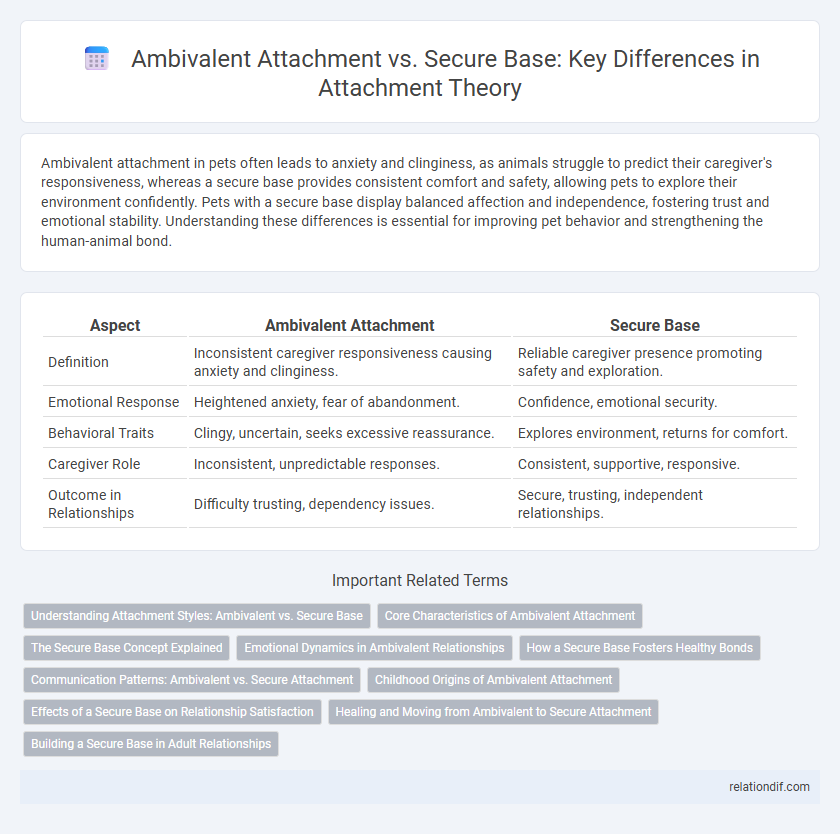Ambivalent attachment in pets often leads to anxiety and clinginess, as animals struggle to predict their caregiver's responsiveness, whereas a secure base provides consistent comfort and safety, allowing pets to explore their environment confidently. Pets with a secure base display balanced affection and independence, fostering trust and emotional stability. Understanding these differences is essential for improving pet behavior and strengthening the human-animal bond.
Table of Comparison
| Aspect | Ambivalent Attachment | Secure Base |
|---|---|---|
| Definition | Inconsistent caregiver responsiveness causing anxiety and clinginess. | Reliable caregiver presence promoting safety and exploration. |
| Emotional Response | Heightened anxiety, fear of abandonment. | Confidence, emotional security. |
| Behavioral Traits | Clingy, uncertain, seeks excessive reassurance. | Explores environment, returns for comfort. |
| Caregiver Role | Inconsistent, unpredictable responses. | Consistent, supportive, responsive. |
| Outcome in Relationships | Difficulty trusting, dependency issues. | Secure, trusting, independent relationships. |
Understanding Attachment Styles: Ambivalent vs. Secure Base
Ambivalent attachment is characterized by anxiety and uncertainty about a caregiver's availability, leading to clinginess and difficulty in exploring the environment confidently. In contrast, a secure base provides consistent emotional support, allowing individuals to feel safe while independently exploring and engaging with their surroundings. Understanding these attachment styles is crucial for recognizing how early caregiving impacts emotional regulation and relationship patterns throughout life.
Core Characteristics of Ambivalent Attachment
Ambivalent attachment is characterized by inconsistent caregiver responsiveness, resulting in heightened anxiety and uncertainty in the child's behavior. Children with ambivalent attachment often exhibit clinginess combined with resistance, showing difficulty in trusting the caregiver as a reliable secure base. This attachment style contrasts with secure attachment, where the caregiver provides consistent support, fostering confidence and exploration.
The Secure Base Concept Explained
The Secure Base concept in attachment theory refers to a caregiver providing a reliable foundation from which a child can explore the world while feeling safe and supported. In contrast to ambivalent attachment, where the child experiences inconsistent caregiver responsiveness leading to anxiety and uncertainty, a secure base fosters confidence and emotional resilience. This consistent availability and sensitive caregiving promote secure attachment, enabling healthy social and emotional development.
Emotional Dynamics in Ambivalent Relationships
Ambivalent attachment reflects inconsistent emotional responses, leading to heightened anxiety and uncertainty within relationships. These individuals often seek reassurance but simultaneously fear rejection, creating a push-pull dynamic that complicates emotional intimacy. In contrast, a secure base provides stability and trust, fostering open communication and consistent emotional support that mitigate the turmoil found in ambivalent bonds.
How a Secure Base Fosters Healthy Bonds
A secure base provides consistent emotional support and safety, enabling individuals to explore their environment with confidence and trust in relationships. Unlike ambivalent attachment, where uncertainty causes anxiety and inconsistent seeking of closeness, a secure base fosters resilience and effective communication. This foundation promotes healthy bonds through stability, mutual understanding, and reliable responsiveness.
Communication Patterns: Ambivalent vs. Secure Attachment
Ambivalent attachment is characterized by inconsistent and anxious communication patterns, where individuals often seek reassurance but simultaneously express doubt or resistance, leading to unclear emotional signals. In contrast, secure attachment fosters open, clear, and consistent communication, allowing for trust and emotional support that strengthens relational bonds. These differing communication styles significantly impact relationship stability and emotional regulation in close connections.
Childhood Origins of Ambivalent Attachment
Ambivalent attachment in childhood often arises from inconsistent caregiver responsiveness, where a child experiences unpredictable emotional availability. This inconsistency disrupts the formation of a secure base, causing anxiety and uncertainty in the child's exploration and emotional regulation. Early caregiving patterns rooted in ambivalence contribute to heightened attachment distress and difficulties in trust development.
Effects of a Secure Base on Relationship Satisfaction
A secure base in relationships fosters emotional safety, enabling partners to explore personal growth while relying on consistent support, which significantly enhances relationship satisfaction. Attachment theory indicates that individuals with secure attachment styles typically report higher levels of trust and effective communication, contributing to greater intimacy and stability. Empirical studies show that secure base behaviors correlate with reduced conflict and increased mutual responsiveness, ultimately strengthening relationship longevity and overall happiness.
Healing and Moving from Ambivalent to Secure Attachment
Healing from ambivalent attachment involves developing consistent emotional availability and trust, which are central to forming a secure base. Therapeutic approaches such as attachment-based therapy and mindful self-awareness can promote emotional regulation and reduce anxiety in relationships. Building a secure attachment requires strengthening positive interactions and nurturing reliable support systems that foster safety and stability.
Building a Secure Base in Adult Relationships
Building a secure base in adult relationships involves fostering trust, emotional availability, and responsive communication that counteracts ambivalent attachment tendencies characterized by anxiety and inconsistency. Emotional regulation and dependable support during times of stress create a foundation where both partners feel safe to explore vulnerability and intimacy. Developing this secure base enhances relationship satisfaction by promoting stability and resilience against attachment-related insecurities.
Ambivalent Attachment vs Secure Base Infographic

 relationdif.com
relationdif.com